BMT Secures US Navy Environmental Contract
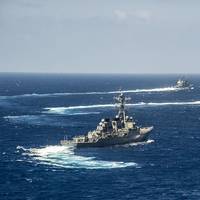
Press release - BMT Designers & Planners, a subsidiary of BMT Group, an international maritime design, engineering and risk management consultancy, has been awarded a United States Navy Environmental Quality Programs Support contract at a value of $43 million over five years. BMT will expand its environmental, engineering and logistics services practice to support the program and other similar client requirements. Under the contract, BMT will provide support services to Naval Sea Systems Command (NAVSEA)…
USCG Makes Headway in Challenging Waters
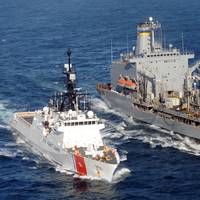
Day after day, the U.S. Coast Guard continues to conduct its 11 statutory missions with its limited resources. It is challenged to Invest in long-term operational capacity while continuing to carry out its daily missions. “We’re a small service, but as always, we do punch above our weight class,” said Coast Guard Commandant Adm. Paul Zukunft during the 2015 Surface Navy Association symposium in Arlington, Virginia. While the Coast Guard may have drifted off course with its ambitious and holistic Deepwater recapitalization effort…
GE Helps US Navy Improve Energy Efficiency
GE’s Power Conversion business was chosen by Naval Facilities Engineering Command (NAVFAC) to build a test system for a cleaner and more productive future in full scale testing of shipboard propulsion and electrical distribution systems at its Naval Ship Systems Engineering Station (NAVSSES). In a traditional testing environment, power transmitted from the grid, passes through a test system and the tested equipment with waste heat is then released to the environment. However, GE’s solution integrates two motors at the end of the cycle that recaptures the energy and recycles it back into the testing system. As a result, it improves overall energy efficiency for the facility and also saves on fuel consumption. In addition, the GE technology reduces carbon emissions from the facility.
Shock Test Machine Saves Navy Big Bucks
The Navy's new Deck Simulator Shock Machine (DSSM) improves shipboard electronics reliability while reducing testing costs as equipment evaluations began in Philadelphia, saving the Navy $75,000 per test, as it meassures the effects of simulated underwater explosions on electronic equipment, informs Naval Sea Systems Command. The mammoth machine evaluates state-of-the-art, vibration-sensitive electronics cabinets weighing up to 1,500 pounds on shock isolation mounts. One of two such machines worldwide, the mechanism sits on 22,000 pounds of steel and concrete and records the effects of simulated underwater explosions on electronics equipment.
Installation of Dry Flexible Coupling on USS Essex (LHD 2)
Engineers at the Naval Ship Systems Engineering Station (NAVSSES), Naval Surface Warfare Center Carderock Division in Philadelphia recently oversaw the installation of dry flexible couplings on the lube oil service pumps and main feed pumps on USS Essex (LHD 2). The new couplings replace grease-lubricated versions eliminating hazardous waste and quarterly maintenance requirements for Sailors. The new couplings will run for a year on Essex before moving forward with installation on other amphibious ships. "The dry flex coupling, a device used to connect two moving parts of a system, replaced grid couplings that required more than three pounds of grease to keep each of the eight on board lubricated, " said Brett Franks, mechanical engineer and machinery alteration program manager.
Carderock Opens Upgraded Maneuvering, Seakeeping Basin
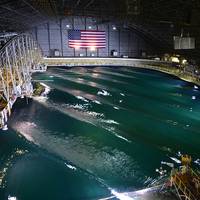
Naval Surface Warfare Center (NSWC) Carderock Division marked the opening of the maneuvering and seakeeping basin (MASK) facility, with a ribbon cutting ceremony, Dec. 19. The 360-foot long and 240 foot-wide facility holds approximately 12 million gallons of water and is used to evaluate the maneuverability, stability and control of scale models. "As I marvel at this triumph of naval engineering and naval architecture, it is gratifying to see that once again the Navy is demonstrating its long term commitment to science, engineering and innovation," said keynote speaker, Dr.
A “Look Under the Hood”

Students glimpse the U.S. On April 25 2013, my family and I went to the Naval Surface Warfare Center, Carderock Division (NSWCCD), Ship Systems Engineering Station (SSES), for national “Take Our Daughters and Sons to Work Day.” Most of the people who work there are engineers. Personnel at SSES design and create extremely technological naval ships and submarines, while figuring out new means of power besides oil. Throughout the day, children and parents were put into nine groups, and each group visited nine stations throughout the facility.
Naval Surface Warfare Center Gets Wavemaking Upgrade
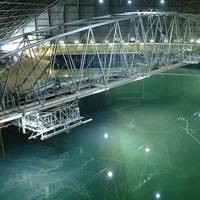
Naval Surface Warfare Center, Carderock Division (NSWCCD) completed major renovations of the Maneuvering and Seakeeping Basin (MASK) facility, Aug. 16. For more than one hundred years, the Navy has built and conducted extensive testing on physical prototypes of ships called scale models before building the real ship in full scale. In 1962, Carderock built the MASK in order to test the scale model performance of ships, platforms and moored systems in realistic sea conditions. The…
Control Systems on LCC 20 Saves Fuel, Reduces Workload
Naval Sea Systems Command completed the installation of new control systems aboard USS Mount Whitney (LCC 20), April 8, which will reduce fuel usage and crew workload. Engineers from the Naval Surface Warfare Center Carderock Division - Ship Systems Engineering Station (NSWCCD-SSES) SSES installed the new control systems on a number of shipboard engineering components and are specifically designed to improve automation on the optimally manned ships. “Military Sealift Command-operated ships like the Mount Whitney traditionally have lower manning levels, therefore being able to operate many systems from one central control unit is essential,” said Matthew Douglass, Auxiliary Machinery Automation Branch head.
Fastener Commonality Deep Dive Yields Navy Supply System Efficiencies
Naval Sea Systems Command completed a fleet-wide fastener study, identifying and recommending the removal of thousands of fasteners from the Navy supply system. The 16-week supply system review identified 108,000 dormant fasteners-fasteners with no contract, requisition or maintenance history in the past five years-and 3,200 duplicate fasteners where two or more identical fasteners had different stock numbers. The NAVSEA Commonality Project management team led the study, collaborating with in-service engineering agents, technical warrant holders, program offices, shipyards, shipbuilders, the Defense Logistics Agency and original equipment manufacturers.
New Control Systems Installed on USS Mount Whitney
Naval Sea Systems Command completed the installation of new control systems aboard USS Mount Whitney (LCC 20), April 8, which will reduce fuel usage and crew workload. Engineers from the Naval Surface Warfare Center Carderock Division - Ship Systems Engineering Station SSES installed the new control systems on a number of shipboard engineering components and are specifically designed to improve automation on the optimally manned ships. "Military Sealift Command-operated ships like the Mount Whitney traditionally have lower manning levels, therefore being able to operate many systems from one central control unit is essential," said Matthew Douglass, Auxiliary Machinery Automation Branch head.
USNS Mercy (T-AH-19) Anemometer Positioning Evaluation (APE) Testing Completed
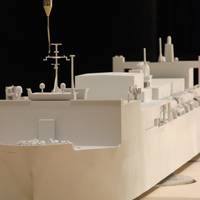
Naval Surface Warfare Center, Carderock Division (NSWCCD) completed Military Sealift Command hospital ship USNS Mercy (T-AH19) Anemometer Positioning Evaluation (APE) testing in support of Naval Air Systems Command (NAVAIR) and Military Sealift Command (MSC), Feb. 8. The testing focused on measuring the airflow of anemometers, wind measurement sensors that are installed on the superstructure of U.S. Navy ships. The APE testing is required to complete the aviation certification process following a new helicopter hangar installation on the ship’s superstructure.
First NEEC Graduate Begins Work at NSWCCD-SSES
PHILADELPHIA - The first graduate of the Naval Engineering Education Center (NEEC) began work February 13 as a naval architect with Naval Surface Warfare Center Carderock Division - Ship Systems Engineering Station's (NSWCCD-SSES) Advanced Machinery Systems Integration Branch in Philadelphia. The NEEC, located in Ann Arbor, Michigan, was launched in July, 2010, to develop the talent of future naval engineers. The educational center was established through a $3.2 million contract award from the Naval Sea Systems Command (NAVSEA), and provides young engineers and scientists access to projects of interest and importance early in their academic careers to build knowledge and enthusiasm for the field.
LCAC 91 Achieves High Speed on Algal Blend
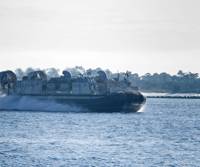
The U.S. Navy successfully concluded its final alternative fuel demonstration for the year today with the Dec. 7-9 operational tests of the 50/50 algae-derived, hydro-processed algal oil and petroleum F-76 blend in a Landing Craft, Air Cushion (LCAC) amphibious transport vehicle at Naval Surface Warfare Center Panama City. The tests also marked the fastest speed achieved to date by a U.S. Navy surface craft using alternative fuel blends, as LCAC 91 reached speeds the crafts maximum speed of 50 knots, Dec.
Oceaneering: $47.5m Navy Contract Modification
Oceaneering International, Inc., Chesapeake, Va., is being awarded a $47,429,395 modification to previously awarded contract (N65540-05-D-0012) to provide continuing Subsafe engineering and technical services to support submarine, Subsafe, and Level I material work onboard Seawolf (SSN 21) class, Los Angeles (SSN 688) class, Ohio class (SSBN), and Virginia class submarines. Work will be performed in Puget Sound, Wash. (60 percent), Norfolk, Va. (30 percent), and Pearl Harbor, Hawaii (10 percent), and is expected to be completed by May 2014. Contract funds in the amount of $15,000,000 dollars will expire at the end of the current fiscal year. The Naval Surface Warfare Center, Carderock Division, Ship Systems Engineering Station, Philadelphia, Pa., is the contracting activity.
DDG 1000 Program Tests Integrated Power System
The Chief of Naval Operations (CNO) observed live tests of the DDG 1000 Integrated Power System (IPS) at the Land Based Test Site at Naval Surface Warfare Center Carderock Division - Ship Systems Engineering Station (NSWCCD-SSES) July 22. DDG 1000 will be the first U.S. Navy surface combatant to use electric power for propulsion and ship services. An IPS generates the total ship electric power requirements, then distributes and converts it for all ship loads, including propulsion, combat systems and ship services. The first successful test of the IPS occurred May 11. CNO Adm. Gary Roughead received an overview of the DDG 1000 program from Capt.
NAVSEA Employees Recognized, ASNE Day 2010
Four Naval Sea Systems Command (NAVSEA) employees were recognized for engineering excellence, April 7-9, by the American Society of Naval Engineers (ASNE) at the society’s conference in Arlington, Va. NAVSEA’s Capt. Albert Grecco, Craig Brandenburg, Stephen Michetti, and Christopher C. Bassler received awards for their accomplishments. NAVSEA develops, delivers and maintains ships and systems on time and on cost for the United States Navy. Grecco received the Gold Medal Award for significant naval engineering contributions during the past five years. “Congratulations [Capt. Albert Grecco] on receiving the Gold Medal Award. You've joined an elite group; having earned the well-deserved, hard-earned recognition of the naval engineering community for producing results ...
NG Upgrades Nav for U.S. Navy Patrol Craft
Northrop Grumman Corporation’s (NYSE: NOC) Sperry Marine business unit has been awarded contracts to upgrade the navigation systems on three U.S. Navy Cyclone-class patrol craft. The bridge upgrade program for the patrol craft is being performed under two cost-plus-fixed-fee contracts from the Naval Ship Systems Engineering Station, Philadelphia, and the Space and Naval Warfare Systems Center Atlantic. Northrop Grumman will equip each of the vessels with an integrated bridge system running under the fleet-standard Voyage Management System (VMS) software. The three-node system is an upgrade to the currently installed Sperry Marine system on the patrol craft.
New Navy Contracts
Bechtel Plant Machinery Inc., Pittsburgh, Pa., is being awarded a $605,030,234 modification to previously awarded contract (N00024-07-C-2102) for additional naval nuclear propulsion components. Work will be performed in Pittsburgh, Pa. (68 percent) and Schenectady, N.Y. (32 percent). Contract funds will not expire at the end of the current fiscal year. No completion date or additional information is provided on contracts supporting the Naval Nuclear Propulsion Program. The Naval Sea Systems Command, Washington Navy Yard, D.C., is the contracting activity. Science Applications International Corp., San Diego, Calif., is being awarded a $9…
New Shipboard Insulation Expected to Save Time and Money
Systems Command's (NAVSEA's) Engineering for Reduced Maintenance (ERM) team outlined Sept. 29 a new thermal barrier materials initiative designed to reduce maintenance expenses, improve shipboard quality of life and reduce shipboard weight. ERM is part of NAVSEA's Naval Systems Engineering Directorate team which seeks to streamline costly and time-consuming maintenance procedures in the fleet. Thermal barriers, the insulation on high temperature pipes and equipment, protect Sailors from serious burns and keep heat from dissipating, improving operational efficiency. Current insulation, commonly called "lagging," consists of up to six inches of a heavy, mortar-like, calcium silicate compound encased in fiberglass cloth.
DOE Recognizes NSWC Carderock for Federal Energy and Water Management
The U.S. Department of Energy (DoE) in selected Naval Surface Warfare Center (NSWC) Carderock, a Naval Sea Systems Command (NAVSEA) field activity, Aug. 18 for the 2008 Federal Energy and Water Management Award. NSWC Carderock is one of two Navy commands to earn the award for its energy efficiency and energy management program in the organization category. "I can't say enough good things about our facilities division, their innovation and dedication," said Capt. Mark W. Thomas, NSWC Carderock Division commander. DoE, in conjunction with the Federal Interagency Energy Policy Committee, sponsors the Federal Energy and Water Management Awards.
Navy Honors Memory of Local Engineering Pioneer
A ceremony was held on November 19, 2001, to rename the Naval Ship Systems Engineering Station’s (NAVSSES) Surface Ship Systems Engineering Complex, the Richard C. Cunningham Engineering Complex. The building (77H) was renamed to honor Cunningham’s pioneering work and engineering innovations in machinery controls and other accomplishments in naval machinery engineering. During the ceremony, Rear Admiral William Cobb, Jr., the Program Executive Officer for Theater Surface Combatants at the Naval Sea Systems Command, presented a special AEGIS Program Lifetime Achievement Award to Mrs. Debra Cunningham on behalf of Richard. The building…
Navy Honors Engineering Pioneer
A ceremony was held on November 19, 2001, to rename the Naval Ship Systems Engineering Station's (NAVSSES) Surface Ship Systems Engineering Complex, the Richard C. Cunningham Engineering Complex. The building (77H) was renamed to honor Cunningham's pioneering work and engineering innovations in machinery controls and other accomplishments in naval machinery engineering. During the ceremony, Rear Admiral William Cobb, Jr., the Program Executive Officer for Theater Surface Combatants at the Naval Sea Systems Command, presented a special AEGIS Program Lifetime achievement Award to Mrs. Debra Cunningham on behalf of Richard. The building…










